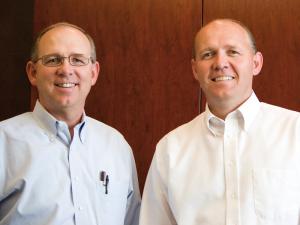My father had been a pharmacist who was tied to his store from 9 a.m. to 9 p.m. every day. He had nine children and wanted us to become doctors, but that was not my game. Instead, I became a CPA. I was working hard to make partner at a regional CPA practice when the firm hit hard times. They lost a major client, pulled in a partner to do my job and let me go. I liked public accounting so I opened my own practice in 1986.
When I started out, I was a true “sole proprietor” and did everything myself. Four years later, I formed a new firm with two partners and a few years after that, we parted ways. I kept my clients, the staff, the receivables and the debt. My brother Mike, who was also a CPA, came to work for me. By 1998, he had bought in and become my partner. We shared the responsibilities of running the practice.
I was working 10 to 12 hours a day year round. I had gone through a divorce and the practice gave me something to concentrate on. But I also felt I could not take my hand off the pressure switch. We didn’t have any real structure and usually reacted to staff issues instead of being in control.
Expecting an increase in growth, we hired four staff over a two-year period; but then the economy took a turn for the worse. We decided not to fire anybody, that we would grow into it. The problem was, the growth was considered my job. Mike and I were under pressure from some staff to increase their pay. I had tried to devise a bonus system but I had no way to increase productivity. To make matters worse, everything was bottlenecking with me. I wanted to take care of clients myself and was reluctant to let go. Although we were big enough to have processes in place, we continued to operate with a smaller-firm mentality.
My other concern was I wanted the practice to perpetuate itself after I retired. I went into public accounting to help people. We didn’t just give clients their completed work and send them our bill; we educated them in the process. They appreciated it and we became friends. I wanted to make sure they would be taken care of when I was gone.
One day I received a letter from another CPA recommending Sterling. He said his practice had been controlling him and that he had been working long hours just to maintain it. That sounded like me so I asked Sterling for a copy of their DVD and watched it with Mike. We felt the concepts made sense, particularly the idea we could be first-class CPAs but not know how to run a practice. Ours was stagnant and we needed a method for managing it.
I then talked with another CPA who was a Sterling client. She was so excited about their program, I presumed she was a newer client. When I discovered she had been a client for seven years and was still excited, I thought there must be something to it. What appealed to us was that Sterling would follow up and ensure we were successful. We signed up.
We started the program with a thorough analysis of the practice by our consultant to get to the root of our issues. Then she wrote a customized plan to address these issues, step by step, and helped us through it. We also took Sterling’s management courses which taught us the correct principles and procedures for managing a practice and its staff. We soon realized we were the ones in need of the most change.
On our consultant’s recommendation, Mike and I examined our revenues to see what each CPA was generating compared to what they should be generating, and what each was being paid. We realized they were overpaid for what they were producing; it was no wonder our growth was stagnant. We decided to take a proactive approach. With our consultant’s help, we devised and implemented a bonus system based on each individual CPA’s billings. Our tax manager quit when he discovered he would have to be productive on an ongoing basis to make more money.
Sterling had taught us about the different types of staff personalities. We had a CPA who was two-faced and made trouble by saying one thing to me and something else to others. She complained, was counterproductive and drove the managers crazy, so we chose to dismiss her. The Sterling program has a way of weeding out the bad staff while helping us find and motivate good staff.
We both learned how to delegate. We empowered the staff to solve their own problems without running to us every time something needed fixing.
Sterling came to our site right before tax season to help us implement the program and get the staff on board. As a result, we had a smoother tax season than ever before. We were on top of the receivables and billed clients with each completed return rather than waiting until month-end; then we followed up.
For the number of CPAs we have, billings are up even though I now can leave the office by 5:30. I have the time to do other things because the practice is not completely on my shoulders. I now enjoy my work and my life more.
The Sterling program changed us, not the practice. We were the cause of our problems and had to change how we operated. Sterling taught us the correct principles and showed us what we were capable of with the right tools.

